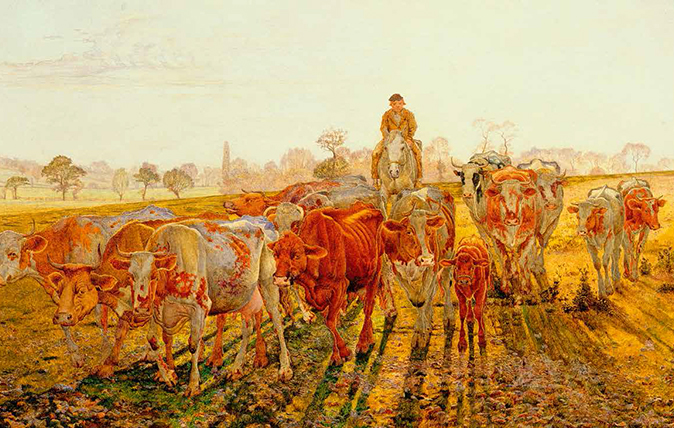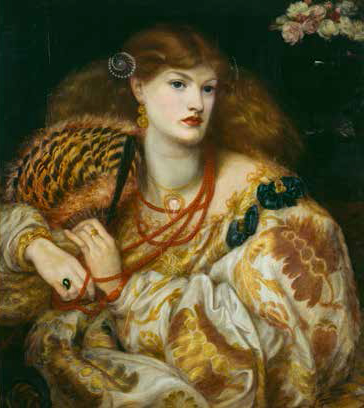'Pre-Raphaelites: Beauty and Rebellion' exhibition review
Simon Poë is delighted to discover an outpost of the Pre-Raphaelite movement in the North of England.


We're accustomed to thinking of Pre-Raphaelitism as a southern, metropolitan phenomenon. The founders of the Pre-Raphaelite Brotherhood (PRB)—John Everett Millais, William Holman Hunt and Dante Gabriel Rossetti—were young men who came together at the royal Academy Schools in London in 1848. The ‘Year of Revolutions’ saw the political ferment sweeping Europe reflected even in the normally placid British art world. However, the Brotherhood was soon to be augmented by a loosely affiliated group of independent-minded northern artists and to acquire some enthusiastic, no-nonsense supporters and patrons in prosperous Victorian Liverpool.
‘Pre-Raphaelites: Beauty and Rebellion’ at Liverpool’s Walker Art Gallery tells a fascinating, but complicated story. The city had a flourishing art scene long before the advent of the PRB. The Liverpool Academy, founded in 1810, ran a school for the training of local artists and mounted a popular annual exhibition. Visiting Pre-Raphaelites were already regular exhibitors and frequent prize winners in Liverpool while they were still struggling to establish themselves in London.
‘Beauty and Rebellion’ includes many familiar and much-loved pictures that were shown at the Academy’s premises in Old Post Office Place during those early years. Their work attracted buyers in the city.

This exhibition traces patterns of patronage through two generations that culminate with William Hesketh Lever, who built the model village of Port Sunlight to house his workers and established the Lady Lever Art Gallery there to display the cream of his enormous collection. It’s still one of the best places in the country to see Pre-Raphaelite art.
The show also includes some of the grand spoils of this later phase of plutocratic accumulation. At redcourt, their luxurious home in Birkenhead, George and Julia Rae amassed one of the first great collections of Rossetti’s work and kept open house for anyone who wished to see it.
Perhaps the most significant of these Liverpudlian patrons, however, was the merchant John Miller. He was previously a shadowy figure, but new research has brought him to life. The only known photograph of him, recently discovered in the archives of the Surrey History Centre, supplies the frontispiece for the important book that accompanies the exhibition.
There was never really anything so coherent as a Liverpool School of painters, but the work brought together in ‘Beauty and Rebellion’ exhibits enough common characteristics to give us a strong sense of what indigenous Liverpool Pre-Raphaelitism looked like. The artists of the city favoured pure landscape more than the rest of the movement did and found many of their subjects fairly close to home in the flatlands of the Cheshire plain, amid the Cumbrian Fells and in mountainous North Wales.
Sign up for the Country Life Newsletter
Exquisite houses, the beauty of Nature, and how to get the most from your life, straight to your inbox.
Their works manifest a taste for bright colour and a commitment to ‘truth to nature’ that they must have learned from the original Pre-Raphaelites. And they often worked on a small scale. Indeed, many of their pictures would have looked lost in the cavernous galleries of the Walker but for a brilliant idea on the part of the designers of the exhibition, who have built three room-sized alcoves, furnished with dadoes and hung with Morris wallpaper, in which to display them.
I particularly loved a painting of cows by Daniel Alexander Williamson, a Welsh mountain landscape by Alfred William Hunt, a study of a roadside pond with a minutely observed fence in the foreground by John Edward Newton and a wonderful little picture of a rain-lashed field by Robert Tonge, in which green corn whips back and forth in the wind and low-flying birds hurry for home.
Although the Pre-Raphaelites found a warmer and more spontaneous welcome in Liverpool than they had in their native South, they were not without detractors even there and, in 1863, the Academy closed its doors for the last time amid bitter controversy and acrimony over the favour that had been shown them. Its failure left a vacuum in the Liverpool art world that would not be filled until the Walker Art Gallery itself opened in 1877.
‘Pre-Raphaelites: Beauty and Rebellion’ is at the Walker Art Gallery, Liverpool until June 5 (www.liverpoolmuseums.org.uk/walker; 0151–478 4199)
Country Life is unlike any other magazine: the only glossy weekly on the newsstand and the only magazine that has been guest-edited by HRH The King not once, but twice. It is a celebration of modern rural life and all its diverse joys and pleasures — that was first published in Queen Victoria's Diamond Jubilee year. Our eclectic mixture of witty and informative content — from the most up-to-date property news and commentary and a coveted glimpse inside some of the UK's best houses and gardens, to gardening, the arts and interior design, written by experts in their field — still cannot be found in print or online, anywhere else.
-
 About time: The fastest and slowest moving housing markets revealed
About time: The fastest and slowest moving housing markets revealedNew research by Zoopla has shown where it's easy to sell and where it will take quite a while to find a buyer.
By Annabel Dixon
-
 Betty is the first dog to scale all of Scotland’s hundreds of mountains and hills
Betty is the first dog to scale all of Scotland’s hundreds of mountains and hillsFewer than 100 people have ever completed Betty's ‘full house’ of Scottish summits — and she was fuelled by more than 800 hard boiled eggs.
By Annunciata Elwes